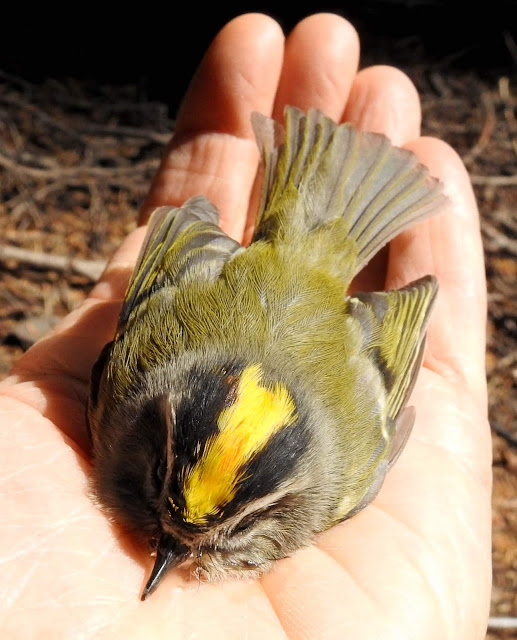Golden-crowned Kinglet - Regulus satrapa
We've had family visiting these past few days, so I haven't had time to blog. However, I did want to share one incredible experience I had this week, while it is still fresh in my memory.
I was hiking on the PCT last Monday with my friends when I noticed a small bird on the trail that looked like it was struggling! It had an incredible bright-orange and yellow patch of feathers on the top of its head, bordered by black and white stripes! It was tiny, about 4" long. Its back, tail, and wings were yellow-green gray in color, with a whitish-gray breast and belly. I didn't know what it was. I picked it up to see if I could help it in some way. Its eyes were tightly shut and it seemed quite weak. My friend put some water in a bottle cap, and surprisingly it took a few sips! After it swallowed the water, its eyes opened up, it spread out its wing and tail feathers, adjusted it's "crown" feathers, and died!!!
Golden-crowned Kinglet - Regulus satrapa
There was no outward indication that it had died, no sudden movement. I just sensed that its spirit was gone. It was as if it had arranged itself and put everything in order just in time for its next journey! I have no idea why it died. There weren't any visible external wounds. We were sad that it had passed away, but felt so privileged to have held it and seen it so closely. Such beauty!
Golden-crowned Kinglet - Regulus satrapa
When I got home I figured out that it was a male Golden-crowned Kinglet! These birds are found across North America. I have since read that they are one of the most abundant bird species found in the dense forests of the Sierra, from 4500'-9000' in elevation. They prefer to remain year-round in these forests. They have unusually thick fluffy plumage that keeps them warm in the winter! In areas of extreme cold, they may even huddle together overnight! They specialize in eating insects at the tips of slender branches, under bark, and in tufts of conifer needles. Their small size and their ability to hover makes this feeding strategy possible. This strategy is apparently quite successful, as they outnumber all other bird species in these forests!
I also read that it is rare to see the "Golden Crown" of this Kinglet, mainly because these birds nest and feed up high in the dense conifers. We were so lucky to have seen this little jewel of a bird in the dark forest! It was an amazing experience!
What birds are around?
Is anything blooming?
What's happening on the river?
Check back next week for the answers to these questions and more!
If all of a sudden you haven't been getting email notices of my blog being published, just sign up again on my blog. I don't know why you got "unsubscribed". It's some kind of problem with Blogspot.com and/or FeedBurner.com. I apologize for this glitch!
Your questions and comments are greatly appreciated!
Please email me at northyubanaturalist@gmail.com



No comments:
Post a Comment